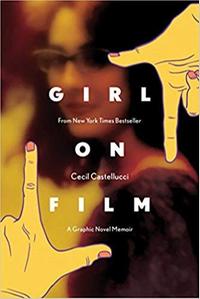 Girl on Film by Cecil Castellucci, illustrated by artists Vicky Leta, Jon Berg, V. Gagnon and Melissa Duffy (Archaia/BOOM! Studios, November 19)
Girl on Film by Cecil Castellucci, illustrated by artists Vicky Leta, Jon Berg, V. Gagnon and Melissa Duffy (Archaia/BOOM! Studios, November 19)
Girl on Film is an original graphic novel memoir by award-winning young adult novelist and Eisner-nominated comic book writer Cecil Castellucci. It's been quite a busy, creative life to look back on: her YA books include Shade the Changing Girl, The Plain Janes and The Year of the Beasts. Her short stories and short comics have been published in various anthologies and literary journals. She is the former children's correspondence coordinator for The Rumpus, a two-time MacDowell Fell and founding YA editor at the Los Angeles Review of Books. She has written two opera librettos and is currently writing The Female Furies for DC Comics. Last but not least, as Cecil Seaskull she was a member of the '90s indie band Nerdy Girl.
Interestingly the impetus for this varied, accomplished career was film--specifically the first Star Wars movie that was released in 1977, which moved her deeply. "I really spent my whole life thinking that I was going to be a filmmaker even as I was doing other things, like being in a band or eventually writing comics," she says. "I think it's funny that though I didn't really do film in the end, film has always been on the periphery of what I do. It is and always will be my muse." Castellucci explains: "I really just love stories. That's what I wanted to do. And films spring from stories."
As a result, Girl on Film is about storytelling and how "we are made up of the stories that we tell about ourselves," Castellucci says. "They form our identity and how we see and navigate the world." And those stories are dynamic. In Girl on Film, Casellucci used what she calls "aspects of cinematic genres" to write her memoir. "It was fun to frame the anecdotes and memories I have with those lenses, which changed the way I viewed my own history."
.jpg) |
|
|
Cecil Castellucci photo by Eric Charles |
|
Another strong influence on her storytelling came from conversations with her father, who is a neuroscientist. "To break down and discuss certain moments and deconstruct the nature of remembering and forgetting with my dad as part of the story was a real trip. It was fascinating to discuss mis-remembering and forgotten things as well as things that are seared into my brain. I learned a lot about how our memories change and mature and fade even when we keep close. It was a real treat to get to tell a story about my story and to make it a story about the stories we tell."
During the process of writing Girl on Film, Castellucci developed great respect for people who write traditional memoirs. "It is very difficult sometimes to look at yourself and really shine a light on the dark corners of the self," she explains. "There are a few moments in the story that I didn't want to tell, that I resisted, because they were scary or unpleasant." Again, talking with her father the neuroscientist helped, she says. "But sometimes it took longer to get motivated to get to the blank page. It is also challenging to leave out so many things from the story. I was surprised at how many stories and anecdotes and people that I consider vital and important had to be left on the cutting room floor."
Working with four artists was a "joy" that fit well with a story about "how memory is hazy and how we change and grow." The artists have interpreted Castellucci's different ages and different moments in a variety of fluid ways. For example, she says, "there is one scene of me at a young age in the movie theater that Melissa Duffy did that I think is probably the most accurate picture of how I remember myself as a 12-year-old. And it's not realistic at all! Things like that are what make comics so great."

